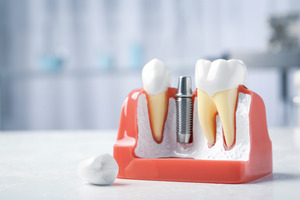3 Procedures You Might Need to Be a Viable Dental Implant Candidate
May 23, 2023

When your periodontist examines your mouth to see if you’re a good candidate for dental implants, sometimes they might find that the answer is no. But that doesn’t have to remain the case! Sometimes it could still be possible to successfully and safely place dental implants in your jaw once the right steps have been taken. Below are 3 examples of preliminary treatments that might allow you to rebuild your smile with expertly placed dental implant posts.
1. Tooth Extraction
Sometimes a tooth might still be in your mouth, but its health has degraded to the point where keeping it is no longer an option. You can replace the tooth with a dental implant – but obviously, that can only happen once said tooth is no longer in your jaw. Hence, it’s very common for tooth extractions to be part of the dental implant process.
Sometimes tooth extraction requires surgery, such as when the tooth in question is severely broken or impacted. However, you can typically have a simple tooth extraction (which is performed with forceps and a dental instrument called an elevator) for teeth that are still visible above the gums.
2. Bone Grafting
When teeth are missing, the jawbone starts to deteriorate. For this reason, it’s recommended that you have dental implants placed within two or three months of tooth loss or extraction. But what if there’s already a significant lack of bone density in your jaw? If that’s the situation you find yourself in, your periodontist might suggest a bone graft.
As part of the bone grafting procedure, bone tissue is transplanted into your jaw. This helps stimulate the growth of new bone, allowing your jaw to regain some of the strength that it lost as a consequence of missing teeth. It normally takes about four to six months after a graft for your jawbone to reach the point where it can support dental implants.
3. Sinus Lift
In many ways, a sinus lift is similar to a bone graft. It also involves the use of transplanted tissue to ensure that there’s enough bone density for implant posts. However, a sinus lift also addresses one other potential concern: the location of your sinus cavity.
As part of a sinus lift procedure, the sinuses are raised up so that grafting material can be placed under them. That way, when you receive dental implants to replace your upper molars and premolars, the posts won’t cause unnecessary damage to the sinus cavity.
The preliminary treatments listed above can extend the dental implant process, but it will be worth it to get a strong, stable new smile that looks and feels like your natural teeth. Don’t be afraid to ask your periodontist about what it will take for you to become a good dental implant candidate.
About the Author
Dr. Justin Braga earned his certificate in Periodontics and his Masters in Craniofacial Biology at the University of Southern California. He is board-certified in both Periodontics and Dental Implant Surgery. His practice, Huntington Beach Periodontics, offers bone grafting and other procedures that can help a larger number of patients enjoy dental implants. To schedule a consultation with Dr. Braga, visit his website or call (714) 587-9094.
No Comments
No comments yet.
RSS feed for comments on this post.
Sorry, the comment form is closed at this time.
